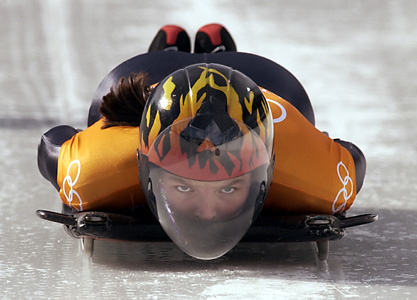Skeleton is a winter sport in which an athlete races head first down an icy course while lying flat on a sled. The sled is also called a skeleton.

Skeleton races are held on outdoor bobsled and luge courses that are about 1,200 to 1,600 meters (1,313 to 1,750 yards) long and 1.4 meters (4.59 feet) wide. Speeds can reach 144 kilometers (90 miles) per hour. Competitors race against time. The individual with the lowest combined time overall wins the competition. Races are held for both men and women.
The skeleton is made of steel and fiberglass. The sled is 80 to 120 centimeters (31 to 47 inches ) long and 45 centimeters (18 inches) wide. The total weight of the sledder and the sled may not exceed 115 kilograms (254 pounds) for men and 92 kilograms (203 pounds) for women, unless the sled does not exceed 33 kilograms (73 pounds) for men and 29 kilograms (64 pounds) for women.
At the start of the run, the sledder pushes off from starting blocks, grips the handles of the skeleton, and runs a distance of about 50 meters (160 feet). The sledder then falls forward onto the sled. The sledder controls the skeleton during the run by slight shifts of body weight. At the finish, sledders sometimes use their feet to brake.
Skeleton grew from a winter sport called cresta, which first appeared in Switzerland in 1892. The first championship event was held in Austria in 1906. Skeleton was a men’s event in the Winter Olympic Games of 1928 and 1948. It returned as an Olympic event for men and women in the 2002 games. The International Bobsleigh and Skeleton Federation governs the sport.
See also Bobsledding .
